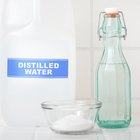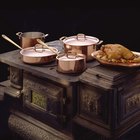Galvanized metal containers are not considered safe for cooking or storage of food. The galvanizing process creates a coating to the metal that prohibits rust. This coating contains zinc, which can be toxic when consumed. Cooking utensils and storage containers are commonly not made of galvanized steel. However, in some cases, galvanized containers, such as garbage cans, are pressed into service for large-scale cookouts or other meals.
Cooking With Galvanized Steel
Heating a galvanized metal surface releases zinc fumes. These fumes accumulate in the food but are also toxic to breathe. For this reason, utensils with galvanized surfaces should not be used in food cooking. This includes using galvanized-surfaced buckets or cans for cooking, as well as any ladles or stirrers. Some larger buckets or cans are available in stainless steel, which is safe for cooking.
Storage of Food in Galvanized Steel
Acidic foods, like pickles and anything including tomatoes or fruit juices, can dissolve and release the zinc of the galvanized surface without cooking. Storage of these types of food in galvanized containers also poses a danger of zinc poisoning.
Galvanized Surfaces
Metal garbage cans are commonly galvanized to prevent rust and are sometimes considered for large-scale outdoor cooking. Some grill-like surfaces such, as metal shelves in old refrigerators, are also galvanized and should not be used for food preparation. If there are any doubts about the composition of a material, it should not be used.
Zinc Toxicity
Symptoms of zinc toxicity include diarrhea, vomiting and fever, starting anywhere from three to 12 hours after consumption. Milk helps neutralize the zinc in the digestive tract and should be given immediately to the individual while professional medical treatment is sought.
Related Articles

Are Nickel Lined Pans Safe?

Is Cooking With Galvanized Aluminum ...

What Kind of Cans Are Used for Canned ...

What "Tools of the Trade" Cookware is ...

The Difference Between a Chafing Dish & ...

Homemade Contact Lens Solution

Symptoms of Food Poisoning With Oysters

Heating Foods in Plastic & BPA

Is It Safe to Bake Vegetables in the ...

Are Aluminum Serving Pieces Safe for ...

Purpose of Moth Balls

Flying With an Ulcer

Alum as an Ingredient in Wrinkle Cream

Cooking With Glass Vs. Ceramic

Oxalic & Phytic Acids in Foods

How to Sterilize Safety Goggles

Are There Foods That Heal Age Spots?

The Disadvantages of Vermicompost

Nutritional Facts of Fava Beans

Are Bell Peppers Nightshade Vegetables?
References
Writer Bio
Keith Allen, a 1979 graduate of Valley City State College, has worked at a variety of jobs including computer operator, medical clinic manager, radio talk show host and potato sorter. For over five years he has worked as a newspaper reporter and historic researcher. His works have appeared in regional newspapers in North Dakota and in "North Dakota Horizons" and "Cowboys and Indians" magazines.